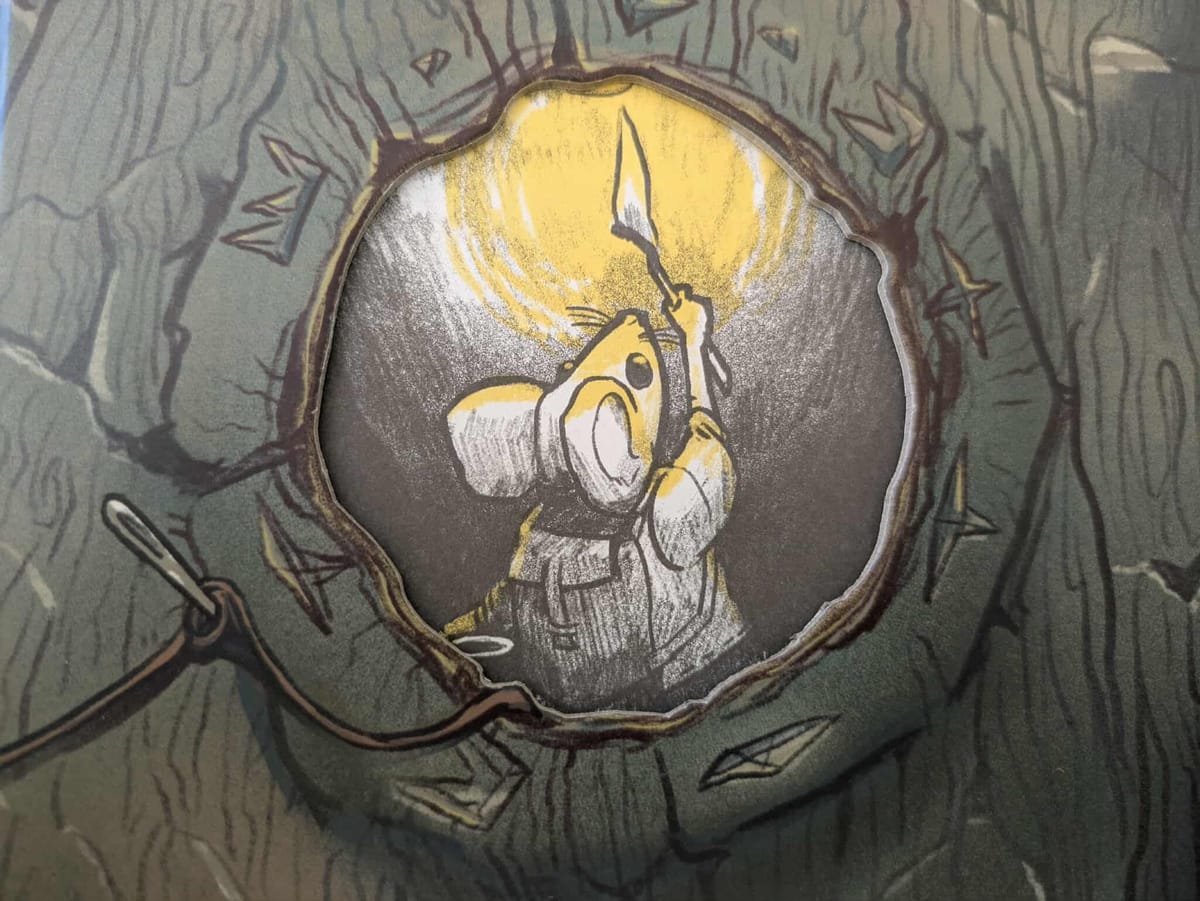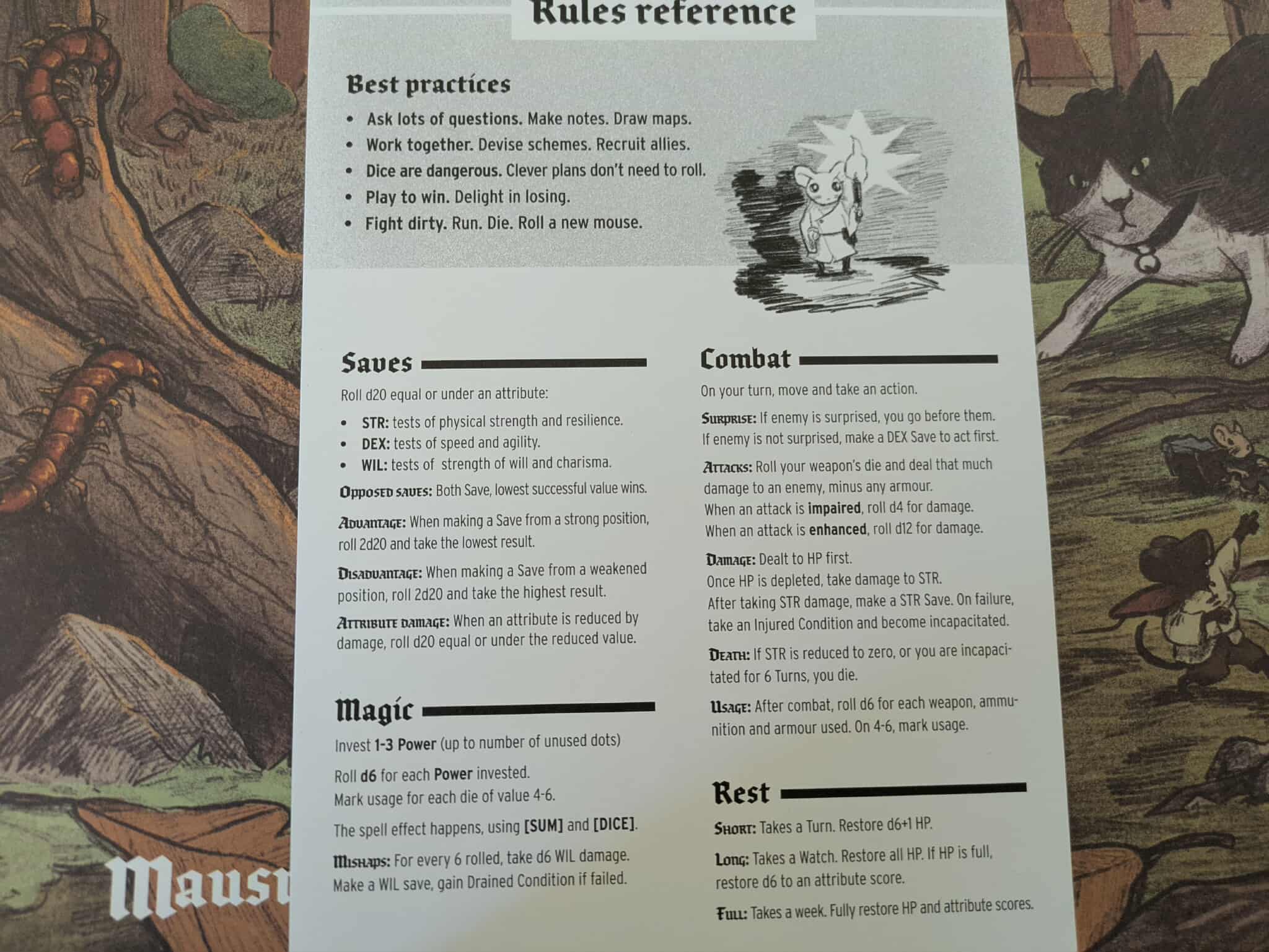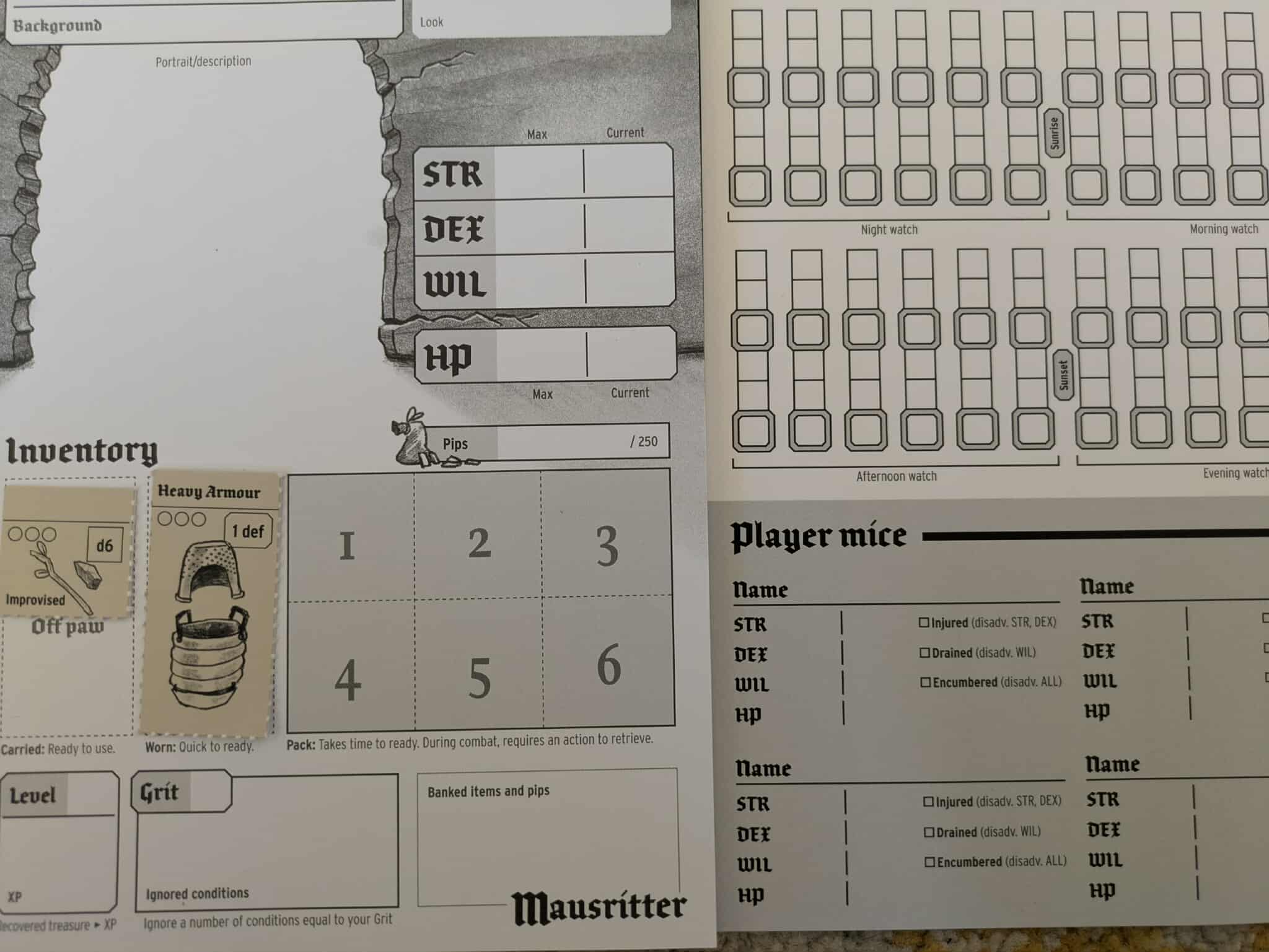
Mausritter is a rare joy to behold as a family RPG, as a physical product, and as a source of ideas for future adventures. From the moment I opened the box until the last page of the rulebook, I was impressed with how much thought was put into the components, the mechanics, and how those elements fit together into a cohesive whole. Mausritter is an RPG based on Into the Odd’s engine, about teams of mice exploring their enormous, threatening world. While the design and presentation receive top marks, its most interesting aspect is the inventory system, a physical puzzle involving placing objects on your character sheet, with light Resident Evil 4 inspiration. The game doesn’t squeeze out every last bit of the potential it promises, bringing up some minor academic problems I found with the rules, but for the amount of material that comes in this set and the quality with which it’s presented, I can easily recommend it to new players of any age.

Materials & Rulebook
I don’t know if I’ve ever seen a game put so much thought into the small things. Maybe making a game about mice inspires that attention to detail. Before you open the box, you see a mouse scouting out the hollow of a tree, an owl looming above. The rulebook’s cover has a hole in it, styled as that tree hollow, and opening it up reveals more of that story unfolding; unveiling details about the world, the mouse, and its plans before entering. That small detail signals so much about how Isaac Williams was able to pack Mausritter with quality and material.
The boxed set is $55 from Exalted Funeral, and the bevy of great material more than justifies its price. Within you will find a packet of character sheets, a turn tracker with reference space for the characters, dry erase markers, punch cards for equipment, spells, and curses, a GM’s screen with important reference materials and tips, a foldout adventure about fighting a bee’s hive, and a rules reference for players that has pretty much everything they could need to know.
All of that is besides the rules themselves, which also held a surprising depth. For a relatively simple family game clocking 43 pages, I wasn’t expecting much material to be included. I was wrong. Mausritter is a perfect example of the conciseness I keep talking about as essential in RPG rulebooks. It isn’t long, but there’s a ton here, including a comprehensive rules reference at the back. Though delivered in an approachable format for a simple game, the rules here offer plenty of combined depth with character creation, equipment, magic, hirelings, overland travel, settlement creation, enemies, factions, and hexcrawls. More than explaining how to run hexcrawls, it has an example hexcrawl map that’s big enough to use for a long time without running over the same territory.
The rules themselves contain a depth and inventiveness that continue to reinforce this feeling of big things in a small package. They are easy to learn, but quickly reveal fascinating choices for your players, and ways for you as a GM to inspire and inform those choices. I can’t talk about some of the best elements of these components any longer without discussing the rules, and the inventory system that lies at the heart of this game’s genius.

Mechanics & Characters
Character creation is simple: each character has three attributes consisting of Strength, Dexterity, and Wisdom as well as Hit Points. Character creation asks you to roll 3d6 for each attribute, with low values being rewarded by extra starting gear. To succeed on a general task, you’ll roll a d20 and succeed if you are equal to or under the relevant stat. You always hit in combat, rolling your weapon’s damage dice to see how hard. Armor provides damage reduction; you can take damage to each attribute, and once you run out of HP you will start taking Strength damage directly. Each time you do, you’ll have to roll against the remaining Strength or take a Condition and become incapacitated. What’s a Condition? To answer that we need to look at the character sheet and finally get into the Inventory system, Mausritter’s most interesting element.

All equipment, spells, and conditions or curses take up physical space on your character sheet. Anything your character is holding takes up slots on the relevant body part or in paw, and anything they don’t have immediately available is stored in their backpack. Conditions eat up space you need for other items, adding a complication to combats other than damage. For example, those bees I mentioned can harm you, but their stings might make you Scabrous, giving you scabbed skin which reduces damage but makes it harder to heal. Each Condition or Curse has its terms written onto it, including specific, thematic ways to clear them.
This inventory management feeds into every item. Weapons and armor task you with rolling a usage die after every battle. Rolling high enough ticks off their three empty slots, and they will break permanently after enough ticks. Spells function similarly, ticking after each use, with methods of recharge that are mystically tied to their function. Fireball, for example, needs to be burned in a large fire for a day and night to be useful again. The spells are in the book and not on the cards, and without space on the sheet you will need another way to track them.
In combat, it takes an action to rearrange your inventory. This feeds into the fundamental mechanism of the strategy: do you use the better weapon that’s closer to breaking down, or the fresher but weaker shiv? With only 2 paws, how do you balance your need for attack and defense? When you get a new Curse, what do you drop for it? Light armor and Heavy Armor have the same damage reduction value and space, but are oriented differently. Light takes up a hand and leaves the head free, while Heavy takes up the body and head space but leaves a hand free. Ranged combat lets you attack from safety, but requires you to manage both the weapon and the ammunition, constantly running the resources down.
There are a few layers of complexity not included that I think will give the game a ton of longevity. I think mechanics around the shape and movement of objects, like a character ability that would let you swap items more easily, or a spell that gives you a temporary extra hand, would play into the rules marvelously. Similarly, most items have the same number of ticks, but differentiating it by material would be interesting. Wood might have fewer than bone, but be smaller and lighter, for example.
These are minor problems, and ones that are easily solved given how simple it is to create your own items and spells. All you need is a square of paper, after all. The cardboard punchouts for equipment are a little flimsy, but that’s not really a drawback. You’re supposed to mark them off, discard them, and make your own. The simplistic rules imply a great flexibility that is sure to inspire you to expand their potential. The one other drawback comes from this game’s focus is limited to combat and dungeon exploration. The rules are built very directly around fighting a variety of woodland creatures and insects, with no real consideration given to social encounters.
The hard tools are almost as important as the soft ones in a game like this: while the rules and inventory are great, the help they give to new GMs are exceptional. With no time wasted, the concise but practical tips mixed with meatier advice tell you what you need to know without burdening you with excessive or confusing text. The sample adventure is a perfect example. In a short foldout it has a reasonably sized area to explore, includes some custom items, and everything you encounter is full of theme, both diegetic and mechanical. If you’ve ever asked yourself what the best starter game is (and you’re comfortable with a bit of violence), Mausritter is the best answer I’ve come across.
Mausritter Boxed Set
Excellent
Mausritter is an RPG that stands out for its attention to detail, cohesive design, and a unique inventory system built around managing physical objects. Set in a world where players control teams of mice, the game blends exploration, combat, and resource management. The game offers a surprising amount of depth in its rules, including character creation, hexcrawls, and magical elements. The system is limited in its focus on combat and exploration of its own mechanics, but offer plenty of ways to inject them into the experience.
Pros
- High quality of components
- Simple rules with tons of depth
- Satisfying, innovative inventory system
Cons
- Very focused on combat
- Leaves some depth on the table
This review is based on a retail copy provided by the publisher.
